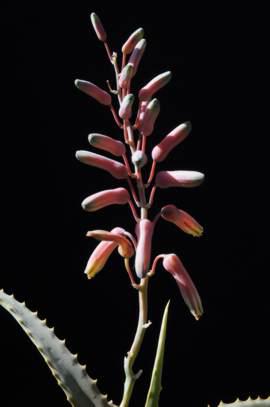Aloe catengiana
Aloe catengiana Reynolds
Family: Asphodelaceae
Common names: Catengue-aloe, Catengue-aalwyn, okandolle (umbundu tongue).
Introduction
Aloe catengiana is only known from the Catengue Railway Station in southwestern Angola. It is a shrubby ascending aloe with spreading, leafy branches up to about 1 m long. It thrives in cultivation and flowers during autumn.

Description
Description
Aloe catengiana is a scrambling shrub, mainly branched from the base, forming thickets with rosettes of about 3m wide. Rosettes are 0.6m across, with the leaves laxly arranged. The leaves are firm, narrowly spear-shaped (lanceolate) and with a pale yellowish grey-green surface, 300×35mm, curving, becoming channelled and less succulent during the dry season and the underside is rounded. The leaf surface is smooth and white-spotted at the base. Leaf margins have firm reddish brown teeth 8-10mm apart. Leaf tips end in sharp points.

The inflorescence is a slender panicle to 0.4m long, composed of several short racemes. The flower buds are orange; the open flowers are tubular and spreading, 28mm long, bright orange-red. The flower segments (perianth) are free for 10mm. Flowering time is mainly during midwinter (August) in the southern hemisphere.
Conservation Status
Status
Several attempts to find Aloe catengiana near the Catengue Railway Station by the author have not proved successful, and the presence of anti-personnel mines (from the Angolan Civil War) further complicates searches for this species.

Distribution and habitat
Distribution description
Aloe catengiana is known only from the Catengue Railway Station in southwestern Angola (about 60 miles southeast of Benguela) and grows at an altitude of 600 m. The area was visited by the author on three occasions to search for more populations. The soil is granitic and associated vegetation consist of mopane savanna (Colophospermum mopane) with Terminalia prunoides, Gyrocarpus americanus along with the occasional baobab (Adansonia digitata). Prominent succulents include Aloe littoralis, Euphorbia gracillima, Fockea multiflora, Cissus cactiforme, Adenium boehmianum, Sarcostemma viminale, Cryptostephanus densiflorus and Plectranthus amboinicus.
The soil is poor in minerals and acidic. Rainfall in the habitat ranges from 300-500mm per annum, and is experienced mainly in summer (in the form of thundershowers).
Derivation of name and historical aspects
History
Aloe catengiana was named by Dr Gilbert Reynolds in the botanical journal Kirkia in 1960, and was named for Catengue Railway Station in southwestern Angola. This aloe was first discovered by Dr Gilbert Reynolds and Dr Neil Smuts during an expedition to Angola in 1959. Aloe catengiana is one of some 29 species of Aloe indigenous to Angola.

Ecology
Ecology
Aloe catengiana is pollinated by sunbirds. The plants proliferate from the base and when damaged by fires will simply re-sprout.
Seeds are dispersed by wind during the spring (July-August), just before the onset of the summer rains.
Uses
Use
No uses have been recorded.
Growing Aloe catengiana
Grow
Aloe catengiana is an easily grown plant and can be propagated by cuttings. Cuttings ranging from 100-150mm in length root rapidly in moist sand during spring or summer. A rooting hormone is not required. The plants grow rapidly, shooting from the base. They can be planted out in containers or on rockeries and a generous application of compost should boost its performance.
Aloe catengiana thrives in dry savanna gardens. It should preferably be grown in full sun. The species proliferates and soon becomes spreading or scandent. It is best grown in well-drained sandy soil and an annual compost dressing will improve its growth performance. When grown in containers the plants should be kept dry in winter and protected from severe frosts. They are fairly pest-free, but will rapidly rot if kept too wet or in poorly drained soil. Aloe catengiana responds well to feeding with organic fertiliser, which should be applied during spring and summer.
References
- Gunn, M. & Codd, L.E. 1981. Botanical exploration of southern Africa. Balkema, Cape Town.
- Reynolds, G.W. 1966. The Aloes of Tropical Africa and Madagascar. The Trustees of the Aloe book fund, Swaziland.
- Van Jaarsveld, E.J. 2013. Aloes of Angola and Namibia. Aloe 50: 1 & 2: 24-29.
Credits
Ernst van Jaarsveld
Kirstenbosch National Botanical Garden
February 2008, Updated May 2014
Plant Attributes:
Plant Type: Shrub, Succulent
SA Distribution:
Soil type: Loam
Flowering season: Autumn
PH: Acid, Neutral
Flower colour: Orange
Aspect: Full Sun
Gardening skill: Easy
Special Features:
Horticultural zones







Rate this article
Article well written and informative
Rate this plant
Is this an interesting plant?
Login to add your Comment
Back to topNot registered yet? Click here to register.